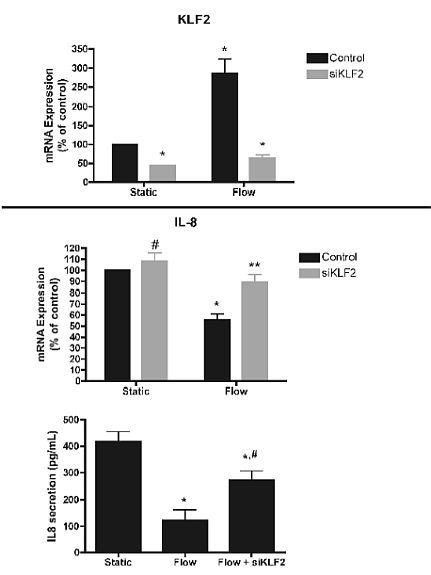Flow Is Critical for Maintaining a Protective Phenotype in Renal Proximal Tubular Cells
Transplant Surgery Research Lab, Harvard Medical School, Brigham and Women's Hospital, Boston, MA
Laboratory for Systems Biology, Center for Excellence in Vascular Biology, Harvard Medical School, Brigham and Women's Hospital, Boston, MA
Renal Division, Harvard Medical School, Brigham and Women's Hospital, Boston, MA
Université
Paris Descartes, Sorbonne Paris Cité, Paris, France
Meeting: 2013 American Transplant Congress
Abstract number: D1547
Background. The impact of flow cessation on proximal tubular cell homeostasis and glomerulotubular balance is of clinical significance during renal ischemia and organ preservation. Consequences of hemodynamic shear stress on the phenotype of tubular epithelial cells and the subsequent expression of pro-inflammatory cytokines have not been explored.
Methods. Transformed human tubular cells (HK-2) were exposed to laminar shear stress of 1dyn/cm2 for 24 to 48hrs to investigate the consequences of this biomechanical stimulus on IL-8 secretion, surface expression of adhesion molecules (VCAM-1, ICAM-1) and KIM-1 secretion as a surrogate for cellular injury.
Results. Our data show that fluid shear-stress down-regulates IL-8 and KIM-1 secretion by HK-2 cells, and the surface expression of VCAM-1 but not ICAM-1. Flow cessation reverted protective effects towards a pro-inflammatory phenotype as displayed by cells under static conditions.

Shear stress up-regulated the expression of the transcription factor KLF2, and silencing of KLF2 curtailed the down-regulation of shear-stress-mediated IL-8 expression

Conclusions. Taken together, our data suggest that shear-stress evokes a “tubuloprotective” phenotype in epithelial cells. These observations may represent a new conceptual framework for the understanding of tubular injury in the context of renal ischemia with clinical relevance for acute kidney injury and transplantation.
To cite this abstract in AMA style:
Timsit M, Adams W, Laguna-Fernandez A, Ichimura T, Bonventre J, Garcia-Cardena G, Tullius S. Flow Is Critical for Maintaining a Protective Phenotype in Renal Proximal Tubular Cells [abstract]. Am J Transplant. 2013; 13 (suppl 5). https://atcmeetingabstracts.com/abstract/flow-is-critical-for-maintaining-a-protective-phenotype-in-renal-proximal-tubular-cells/. Accessed December 14, 2025.« Back to 2013 American Transplant Congress
